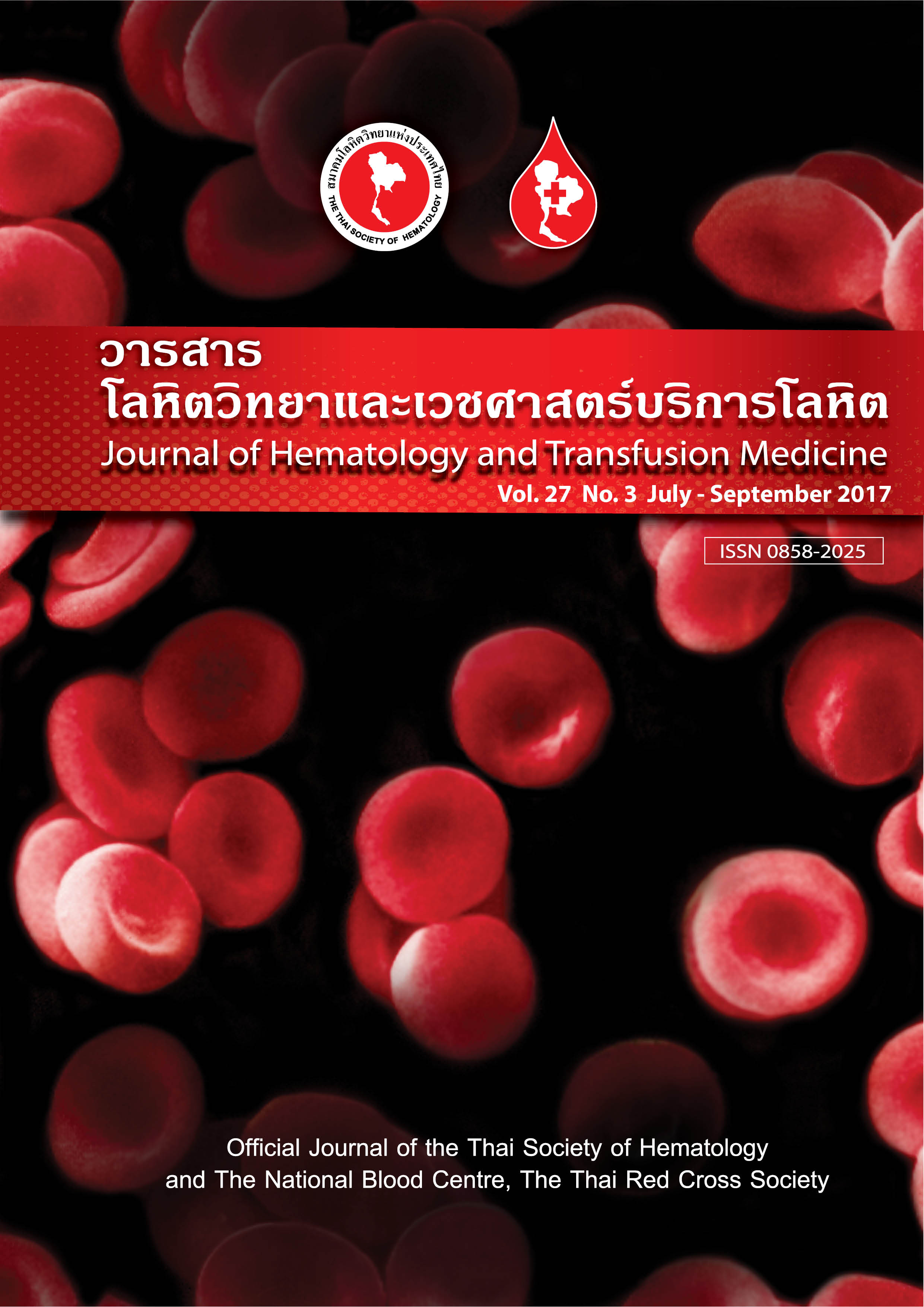การนำวิธี Real-time PCR มาใช้สำหรับการตรวจชนิดเอชแอลเอในผู้บริจาคอวัยวะสมองตาย
Keywords:
HLA, Real-time PCR, Deceased donors, Kidney transplantAbstract
บทคัดย่อ
ความเป็นมา การตรวจหาแอนติเจนเม็ดโลหิตขาว (human leukocyte antigen, HLA) ในผู้บริจาคไตสมองตายนิยมใช้วีธีพีซีอาร์ (polymerase chain reaction, PCR) เช่น PCR-sequence specific primers (PCR-SSP) ซึ่งมีขั้นตอนและใช้เวลาในการเตรียมน้ำยา และอุปกรณ์ในขั้นตอนหลังปฏิกิริยา PCR (post PCR) ในปัจจุบันได้มีการพัฒนาการตรวจด้วยวิธี real-time PCR ในการทดสอบ HLA typing ซึ่งมีข้อดีคือ ได้ผลการตรวจวิเคราะห์รวดเร็วกว่าวิธี conventional PCR วัตถุประสงค์ เพื่อประเมินการทดสอบ commercial real-time PCR สำหรับการตรวจ HLA typing ในผู้บริจาคไตสมองตาย วัสดุและวิธีการ ใช้ตัวอย่างจำนวน 47 รายที่ได้จากการทดสอบความชำนาญซึ่งทราบผลการตรวจอัลลีล HLA แต่ละ locus ด้วยวิธี PCR-SSP, PCR-sequence specific oligonucleotide probe (PCR-SSO) และ/หรือ sequence-based typing (SBT) เปรียบเทียบกับผลการตรวจ HLA-A, -B, -C, -DRB1, -DRB3/4/5, -DQB1 และ HLA-DPB1 ด้วยวิธี real-time PCR โดยใช้สถิติเชิงพรรณนา ผลการศึกษา จากการเปรียบเทียบผล HLA typing พบว่า ผล HLA typing ทั้ง HLA-A, -B, -C, -DRB1, -DRB3/4/5, -DQB1 และ -DPB1 ด้วยวิธี real-time PCR กับ PCR-SSP, PCR-SSO และ/หรือ SBT มีความสอดคล้องกัน 97.9% โดยพบปัญหาการแยกชนิดระหว่าง HLA-B*15:02 และ HLA-B*15:25 ใน 1 ตัวอย่าง ซึ่งเมื่อตรวจด้วยวิธี PCR-SSO พบว่าเป็น B*15:02 ซึ่งตรงกับวิธี PCR-SSP แต่วิธี real-time PCR ใช้เวลาในการตรวจน้อยกว่าวิธี PCR-SSP ถึง 2 เท่า และขั้นตอนการแปลผลใช้โปรแกรมสำเร็จรูปจึงสะดวกในการสรุปผล สรุป การศึกษานี้ได้ตรวจอัลลีล HLA ด้วยวิธี real-time PCR ซึ่งเมื่อเปรียบเทียบผลกับวิธีพีซีอาร์ชนิดอื่น สามารถรายงานผลการตรวจได้ถูกต้อง แม่นยำ แต่อาจมีข้อจำกัดที่ไม่สามารถแยกอัลลีลของ HLA-B*15 บางชนิด ดังนั้นการใช้วิธี real-time PCR จะช่วยลดขั้นตอน และเวลาในการทดสอบจึงประยุกต์ใช้กับการตรวจ HLA typing ในผู้บริจาคไตสมองตายได้ต่อไป
Abstract:
Background: The polymerase chain reaction-sequence specific primers (PCR-SSP) is currently used to type human leukocyte antigen (HLA) in deceased donors. This technique requires multiple steps and is time consuming due to post PCR process. Currently, the real-time PCR technique which has faster turn-around time has been applied for HLA typing. Objective: To evaluate the use of commercial real-time PCR assay for HLA typing in deceased donors. Material and Methods: Altogether, 47 samples from proficiency testing that had previously been HLA typed for each locus by PCR-SSP, PCR-sequence specific oligonucleotide probe (PCR-SSO) and/or sequence-based typing (SBT) techniques were included. Previous HLA results (HLA-A, -B, -C, -DRB1, -DRB3/4/5, -DQB1 and -DPB1) were compared with real-time PCR assay by descriptive statistics. Results: The comparison of HLA typing results (HLA-A, -B, -C, -DRB1, -DRB3/4/5, -DQB1 and -DPB1) from real-time PCR versus PCR-SSP, PCR-SSO and/or SBT showed 97.9% concordance. The inability to differentiate between HLA-B*15:02 (75) and HLA-B*15:25 (62) by real-time PCR assay was detected in one example and the confirmation result by PCR-SSO was B*15:02, identical to the PCR-SSP result. Interestingly, test time of the real-time PCR was 2 times less than PCR-SSP. The software program was used to analyze HLA typing results. Conclusion: HLA typing using real-time PCR could provide accurate results compared with other PCR techniques. The limitation of differential detection in some HLA-B*15 was found. Therefore, the real-time PCR for HLA typing could provide less test steps and time consuming, which can be implemented in deceased kidney donor typing.



